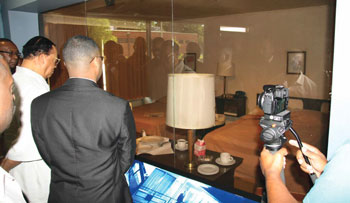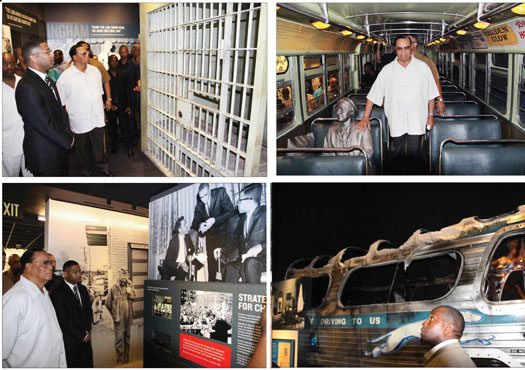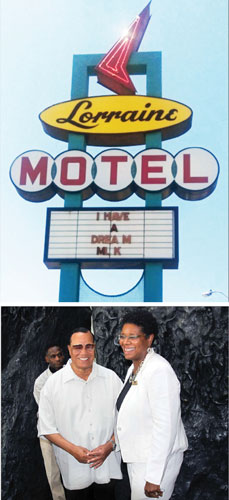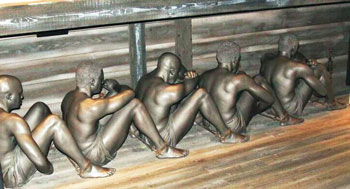A tour of historic National Civil Rights Museum and reflection on the King legacy
By Ashahed M. Muhammad -Assistant Editor- | Last updated: Aug 28, 2015 - 12:07:36 PMWhat's your opinion on this article?

(R) Min. Farrakhan at The National Civil Rights Museum, formerly the Lorraine Motel on balcony where Dr. Martin Luther King Jr. was fatally shot. Photo: James Muhammad (L) The Rev. Martin Luther King Jr. stands with other civil rights leaders on the balcony of the Lorraine Motel in Memphis, Tenn., on April 3, 1968, a day before he was assassinated at approximately the same place. From left are Hosea Williams, Jesse Jackson, King, and Ralph Abernathy. Photo: AP/Wide World photos
|
The location is well known because it was on the balcony of the motel where the Rev. Dr. Martin Luther King Jr. was shot down by an assassin’s bullet April 4, 1968. The museum opened in 1991 and underwent major renovations in April 2014.

Museum display preserves the room where Dr. King spent his last night. Photo: James Muhammad
|
“I thought as I was getting out of the car how many of our Christian brothers and sisters, when they go into the holy land, they want to visit the place where Jesus was born, they want to visit the place where Jesus gave his life for humanity,” said Min. Farrakhan. “As I stand in this place, it is really a sacred place because here is where our brother gave his life for a cause that would make men free of ignorance and hate, and it really is a great privilege to stand in this place, especially on the balcony where he gave his life.”

(CCW) Min. Farrakhan at Civil Rights Museum a replica of cells where Dr. King and others were jailed. | Min. Farrakhan stands on the bus with sculpture of Rosa Park and has a moment of reflection. | Civil Rights Museum display highlights work of Minister Malcolm X. | Burned out bus from 1960s Freedom Rides.
|

Min. Farrakhan is welcomed to the National Civil Rights Museum in Memphis by museum president Terri Lee Freeman.
|
The tour covers the time period of 1619 to 1975 with major exhibits featuring notable events occurring during the civil rights movement. Museum educator Ryan Jones led the tour describing the Jim Crow Era, the Montgomery Bus Boycott, Student Sit-ins and Freedom Rides of the early 1960s, the March on Washington in 1963 as well as the historic Voting Rights Act in 1965. There are also displays with items from the Black Power movement from 1966-1975.
Minister Farrakhan stopped numerous times reflecting on the exhibits and displays. He paused for a moment while at the exhibit where Rosa Parks decided she would not give her seat up for a White man. An incredibly poignant moment was when Min. Farrakhan stood on the exact spot where Dr. King, was shot down.
Despite advancements in some areas, Min. Farrakhan said the poor are still poor and Black people are still being slaughtered, which is why those who are left behind must work to honor a man of Dr. King’s greatness by working to fulfill the purpose of his life.

A replica of the hold of a slave ship is at Civil Rights Museum. Photo: James Muhammad
|
“He did not die because he had a dream,” said the Minister. “He died because he awakened from that dream and spoke words in the last few years of his life that turned many against him.”
INSIDE STORIES AND REVIEWS
-
-
About Harriett ... and the Negro Hollywood Road Show
By Rabiah Muhammad, Guest Columnist » Full Story -
Skepticism greets Jay-Z, NFL talk of inspiring change
By Bryan 18X Crawford and Richard B. Muhammad The Final Call Newspaper @TheFinalCall » Full Story -
The painful problem of Black girls and suicide
By Charlene Muhammad -National Correspondent- » Full Story -
Exploitation of Innocence - Report: Perceptions, policies hurting Black girls
By Charlene Muhammad -National Correspondent- » Full Story -
Big Ballin: Big ideas fuel a father’s Big Baller Brand and brash business sense
By Bryan Crawford -Contributing Writer- » Full Story






 Click Here Stay Connected!
Click Here Stay Connected!








